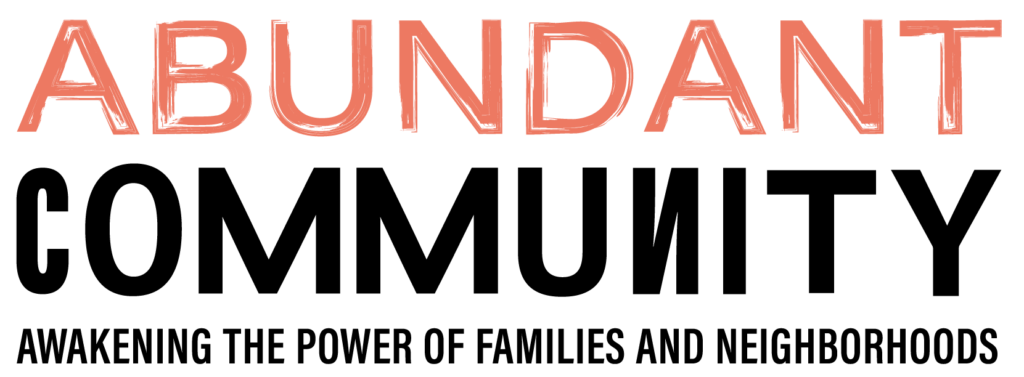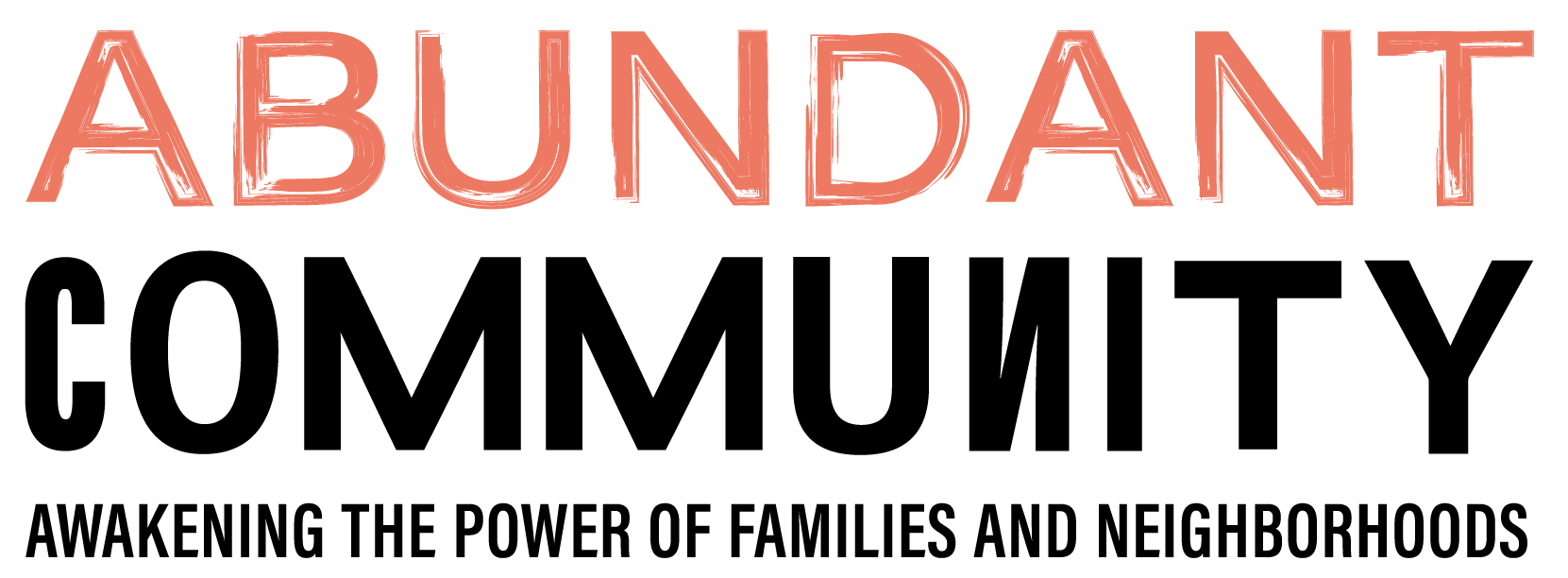This unique story from Menasha, Wisconsin reveals what is possible through the steady efforts of just one person to create a culture of connection and relationship. Read how her ongoing conversations and relationships with neighbors created the conditions an upwelling of caring connection and community problem-solving when the COVID-19 pandemic struck.
A Neighbor-Based Pandemic Response: Jefferson Park Neighborhood, Menasha, Wisconsin
by Julie Filapek, Goodwill NCW/Neighborhood Partners and Vicki Bokelman, Jefferson Park Neighborhood
Vicki Bokelman is the Connector for her Jefferson Park Neighborhood, a mostly low-to moderate-income area of Menasha, a community in the Fox Valley region of Wisconsin that is often top of mind when community leaders survey the landscape of human needs.
When the COVID-19 pandemic arrived, these community leaders – including those from the human service, foundation, health, and government realms – formed a collaborative community response team that met multiple times per week to coordinate action on food, housing, health, education, and other flashpoints. They also formed a committee to address the dangers of social isolation for mental health. The social connection team promoted a pre-existing Emotional CPR course and warmline, and created a script that agencies, churches and other organizations could use to reach out to their memberships.
At the grassroots in neighborhoods, pandemic response efforts were also underway, perhaps nowhere more actively than in the Jefferson Park Neighborhood, where Vicki Bokelman had spent the prior year meeting and connecting neighbors. The story of the Jefferson Park Neighborhood is an example of asset-based community development and the organic, mushrooming action that can happen when community members are connected and care about one another.
In Vicki’s words, this is the Jefferson Park Neighborhood’s pandemic story:
The summer prior to the pandemic, I became a Neighborhood Partners Connector for my neighborhood, and started an asset discovery project, knocking on as many of the 800 homes in my neighborhood as possible to learn what my neighbors’ knowledge, skills and interests are, and what they care about. Our goal was to help those neighbors to share their gifts with young people in the neighborhood. We were able to make some of these connections at our local elementary school and Boys and Girls Club before COVID hit and what we learned from knocking on doors became useful in ways we could never have envisioned.
Mutual Aid Group
The first thing our neighborhood did in response to the pandemic was to offer a mutual aid online survey to gain information about neighbors who could offer, or who needed, help. Over 40 people offered to help, so we organized both an email and a text Neighbors Helping Neighbors group where we encouraged people to check in with their neighbors via a phone call or notes left on doors, since many were not receiving our electronic communications. Very few people have ever come forward seeking help from this group, but among those who did, we have great story:
A woman who joined the mutual aid group reached out about her upstairs neighbor, a young, single mother of a kindergartner and pregnant with twins. With no transportation and no family around to help, the woman knew that this young mother could use food and more. As soon as one person offered a gallon of milk, the texts began multiplying with what other neighbors could offer. One, from COVID quarantine, donated money, while another already at the grocery store picked up extra food with those funds. Another neighbor had extra blankets and a bed. Toys were offered, and household goods. By the end of the afternoon, a half dozen people had dropped things off at a neighbor’s door who was unknown to them that morning. Relationships developed in all directions. Neighbors took the mother to doctor appointments, helped with an Easter dinner and basket for the daughter, and when it came time for the twins to be born, an especially involved and supportive neighbor was present in the delivery room.
Through this process, it became clear to us that the woman who originally contacted the group could herself use some help, but was focused instead on helping her neighbor and sharing what she had. This was a lesson we learned about forming a neighborhood mutual aid group: it is easy to find people willing to help, but it is through relationships that people’s needs are revealed.
Jump Around
Early in the pandemic, numerous radio stations across the state 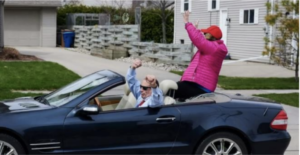
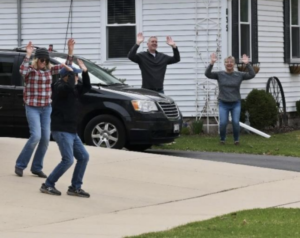 coordinated a campaign to play the song “Jump Around” on Saturdays at 3pm to boost spirits with the Safer-at-Home restriction. The song is a favorite during University of Wisconsin-Madison football games. I entered a contest to bring a radio station vehicle to blast the song to Third Street, where I live. I didn’t win, but I did call neighbors on my street to invite them to come outside anyway, and several of them did. My husband and son and paraded the Jefferson Park Neighborhood’s banner, played the song from a small portable speaker, and neighbors jumped around!
coordinated a campaign to play the song “Jump Around” on Saturdays at 3pm to boost spirits with the Safer-at-Home restriction. The song is a favorite during University of Wisconsin-Madison football games. I entered a contest to bring a radio station vehicle to blast the song to Third Street, where I live. I didn’t win, but I did call neighbors on my street to invite them to come outside anyway, and several of them did. My husband and son and paraded the Jefferson Park Neighborhood’s banner, played the song from a small portable speaker, and neighbors jumped around!
We had so much fun that we decided to share the idea with the rest of the neighborhood, and over the next three Saturdays brought the parade to a different street. I announced via our neighborhood organization’s email list the schedule, then reached out to several people that I had learned during my asset discovery work had classic cars they might want to show off (and blast the music from their radios). One of these, a car club president, invited her friends. A Second Street neighbor printed and distributed an invitation to her block, and with the phone numbers I had, we reached out to several others with a personal invite and to check in with them. The following week, a First Street neighbor personalized the Second Street invitation and distributed it along her entire street. More cars joined the parade, including a convertible with the owner waving like a queen from her perch in the back. More neighbors were out on their sidewalks or porches, jumping, waiving, and cheering, and a neighbor with a drone camera shot and produced a short promotional video that we shared with the neighborhood prior to the last event on Broad Street.
Parades for Good
On First Street, our parades began to take on new meaning. A neighbor with access to a large quantity of bread asked if he could distribute it during the parade along with a WE ARE ALL IN THIS TOGETHER message and information on how to connect with the neighborhood group. Over a couple weeks, we distributed 200 loaves of bread, with many neighbors helping to identify people on their block they thought might especially appreciate the gift, and some neighbors meeting for the first time through these connections.
The next week, on Broad Street, neighbors decided to use the parade to honor our front-line workers, knowing that a good number of our own neighbors work those jobs.
One neighbor donated funds and others purchased blue plastic tablecloths that they cut into long strips and packaged with Jefferson Park Neighborhood contact information and an encouragement to tie to front yard trees.
Weeks later, the City cancelled its annual Memorial Day parade, so we stepped in with our own to honor veterans and highlight our small neighborhood businesses. Five neighbors honored a family member carrying their photographs and flags; two neighbors, veterans themselves, drove their classic cars; and four neighborhood businesses joined with their vehicles. 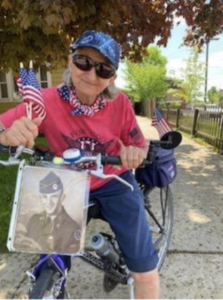
Our historic, iconic bakery had just reopened after COVID lockdown, and passed out free cookies and coupons.
All together, about 30 neighbors came together to make these parades happen, in an initiative that grew organically from one person’s idea, drawing people in based on the gifts they had to share and their ideas about what would be good for the community.
Little Free Pantries
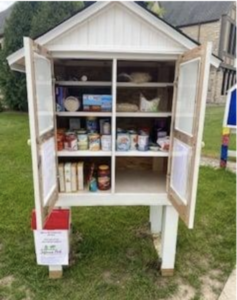 While the parades were happening, neighbors noticed that our nearby library’s Little Free Pantry (established pre-COVID), was running empty, so several neighbors set up a Zoom call to discuss what neighbors might do to help. From past volunteer experience with community food pantries our group concluded that the need existed for hygiene/household products that neighbors wouldn’t receive at a community pantry. A neighborhood carpenter built two mansion-size pantries, which we sited at the local elementary school at the center of our neighborhood, and at an apartment complex that housed many low-income tenants. Another neighbor purchased containers to be attached to the food pantries to hold our neighborhood newsletter. The committee created a donation request flyer and seven neighbors hand-delivered them to all 800 households, which filled the pantries.
While the parades were happening, neighbors noticed that our nearby library’s Little Free Pantry (established pre-COVID), was running empty, so several neighbors set up a Zoom call to discuss what neighbors might do to help. From past volunteer experience with community food pantries our group concluded that the need existed for hygiene/household products that neighbors wouldn’t receive at a community pantry. A neighborhood carpenter built two mansion-size pantries, which we sited at the local elementary school at the center of our neighborhood, and at an apartment complex that housed many low-income tenants. Another neighbor purchased containers to be attached to the food pantries to hold our neighborhood newsletter. The committee created a donation request flyer and seven neighbors hand-delivered them to all 800 households, which filled the pantries.
One especially committed neighbor took charge of keeping the pantries stocked after the initial donation drive, communicating which products were in demand and often using her own stimulus money to re-stock. With COVID, neighbors were out walking more frequently, so that same neighbor hand-painted donated yard signs with Please
Keep Our Little Free Pantries Filled messages, and five households strategically across the neighborhood hosted them. In the weeks to come, a schedule was set and seven “Food Fairies” volunteered their time, once every 2 weeks, to check on and fill the pantries with the donations stored in my garage.
By the fall, however, we were struggling to keep the pantries filled. As my asset discovery door knocking continued throughout the summer, I met a mom with a teenage Boy Scout looking for a volunteer community project. The annual Boy Scout spring food drive had been cancelled due to COVID, so I indeed had an idea in mind! For more than a month we planned and then pulled off a neighborhood contactless food collection. Nine neighbors hand-delivered information door-to-door. Five Boy Scout families and five neighborhood families volunteered on food collection day. Each team had one street, one car and driver and two runners, all total collecting donations from nearly 100 homes. We spent the rest of the morning separating and labeling boxes by food category and stored them in my garage. What an experience to be part of, overwhelmed with the kindness of our neighbors and the abundance of donated food, hygiene, and household goods. We are stronger when we work together!
Even so, we knew we needed a way to sustain the pantries over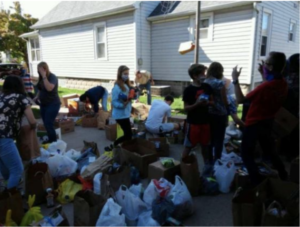 time. The food drive was an amazing experience, but a ton of work, and occasional calls for donations were not going to keep the pantries stocked through the winter. So a reach beyond the neighbors was necessary. A local bar donated their 50/50 raffle proceed in July, which gave us the idea to engage our local businesses in a sustained way. So in September, six businesses – three bars, a gift shop, a café and a take-and-bake pizza shop – agreed to sell fundraising candy bars at their counters. In just the first week, those businesses sold twelve boxes of forty. We have restocked the candy bars and the pantries multiple times since then; at this writing in January, the neighborhood has profited more than $1,000 for our pantries.
time. The food drive was an amazing experience, but a ton of work, and occasional calls for donations were not going to keep the pantries stocked through the winter. So a reach beyond the neighbors was necessary. A local bar donated their 50/50 raffle proceed in July, which gave us the idea to engage our local businesses in a sustained way. So in September, six businesses – three bars, a gift shop, a café and a take-and-bake pizza shop – agreed to sell fundraising candy bars at their counters. In just the first week, those businesses sold twelve boxes of forty. We have restocked the candy bars and the pantries multiple times since then; at this writing in January, the neighborhood has profited more than $1,000 for our pantries.
This note was left in one of the pantries:
To everyone who helps keep this little pantry stocked: I just want you to know I am a 48 year old single woman who works 40 hour/week or more. But because I make $96 a month too much, I don’t qualify for food stamps, and because I work first shift I can’t make it to the food pantry. So this little box is a true blessing for me. I’m not trying to talk bad about anything or anyone, but Ive seen other little pantries and stopped (several times) but it’s always been stocked with stuff that either out of date (I mean years) or stuff you often don’t use that it makes me feel like a beggar or only worthy of having something that someone was probably (and should have) tossed in the trash. But that’s never been the case when I’ve come here. Heck tonight I took some yummy mini cupcakes, an onion I can use, some cinnamon and banana bread. I even took home syrup and frozen waffles, which my 7 year old niece will LOVE when she sleeps over this weekend. But my point is . . . you do an EXCELLENT job and your kindness is very much appreciated! Bless you.
Staying Connected
We continue to rely on our Facebook page and our yard signs to keep our neighborhood aware of the need for pantry donations, and in the fall a local funder offered an opportunity for grassroots, non-501(c)3 organizations to win support for COVID-related projects. We applied and received a grant to purchase fifteen permanent yard signs, sited on front lawns across the neighborhood, which will not only promote Little Food Pantry donations, but also other community activities, especially important during this continued time of isolation. Our “Sign Sitters” consider themselves ambassadors for the neighborhood group, sharing information and meeting new neighbors who stop to look. In November, each of them came up with something they were thankful for to share on their sign to shine some positive light in the beginning of long Wisconsin winter.
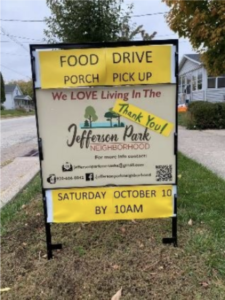 As a neighborhood, we gave up all of our traditional events for the sake of public health – potluck picnics in the park, our annual front porch music festival, a spring kite-flying event for families, an entire schedule of neighbors offering to teach their skills to young people after school. So many events that in the past brought us together. We quickly found that we needed to be creative in offering opportunities for neighbors to connect while physically distanced. We engaged more over the holidays over social media, with neighbors submitting photos of their Christmas lights and their ugly sweaters,but then decided to start the new year with a celebration. So on New Year’s Eve we hosted a Bell Ringing gathering. A group of us met in our park, shared our dreams for the year ahead, and rang our bells for the neighborhood. Like we had all year, we did what we could do safely, with what we had.
As a neighborhood, we gave up all of our traditional events for the sake of public health – potluck picnics in the park, our annual front porch music festival, a spring kite-flying event for families, an entire schedule of neighbors offering to teach their skills to young people after school. So many events that in the past brought us together. We quickly found that we needed to be creative in offering opportunities for neighbors to connect while physically distanced. We engaged more over the holidays over social media, with neighbors submitting photos of their Christmas lights and their ugly sweaters,but then decided to start the new year with a celebration. So on New Year’s Eve we hosted a Bell Ringing gathering. A group of us met in our park, shared our dreams for the year ahead, and rang our bells for the neighborhood. Like we had all year, we did what we could do safely, with what we had.
— Vicki Bokelman
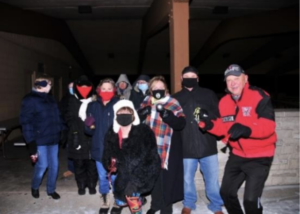
In January, several of the neighbors who were most involved in the activities described in Vicki’s story gathered to debrief on their experience. Facilitated by the Kettering Foundation’s Michele Archie, neighbors created a Ripple Effects Map of their pandemic response activities and what they meant for them, their neighbors and the neighborhood community at large. Several themes emerged from that conversation:
- Discovering the gifts that neighbors have to share with their community was key to the development of this initiative. Without Vicki’s knowledge of neighbors and what they had to share, a good portion of the activities described above would likely never have happened.
- Where institutions stepped back (Boy Scouts from their food drive, the city from its Memorial Day parade) the neighborhood community stepped in to fill those functions
- When neighbors stepped forward to take action, it was relatively easy to bring local businesses and institutions on board to help.
- Informal groups of neighbors working together can be flexible and creative in how they approach a problem if they stay open to what people have to share. When a neighbor wanted to share bread, that’s what they did. When another neighbor wanted to share front-line blue ribbons, that’s what they did.
- The Jefferson Park Neighborhood group (est. 2016) focused in its early years on promoting social connections among neighbors, and more recently on asset discovery. Through this pandemic response experience, they are realizing that there are many needs to be addressed and that they have an important role in meeting them.
The story of the Jefferson Park Neighborhood’s pandemic response activities was highlighted in the final weekly meeting of the COVID community response team and is being showcased by the local community foundation as an inspiring story of community resilience. It is our hope that stories like this one will drive more investment in grassroots approaches to addressing all kinds of issues and needs in the local community.
